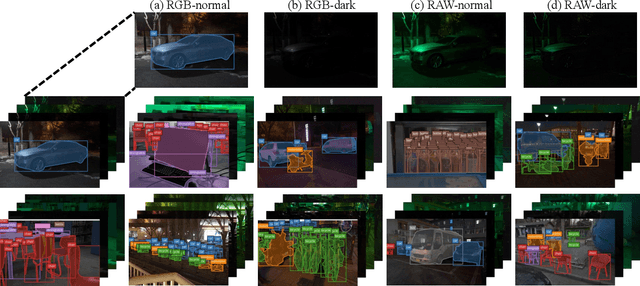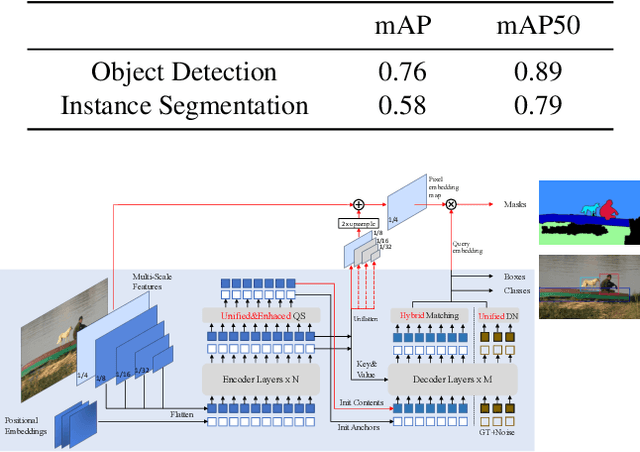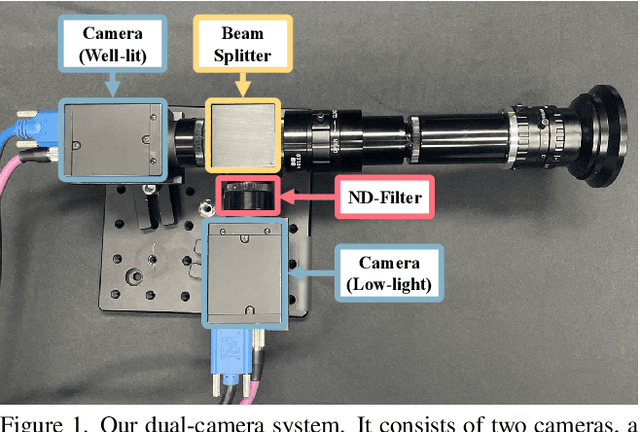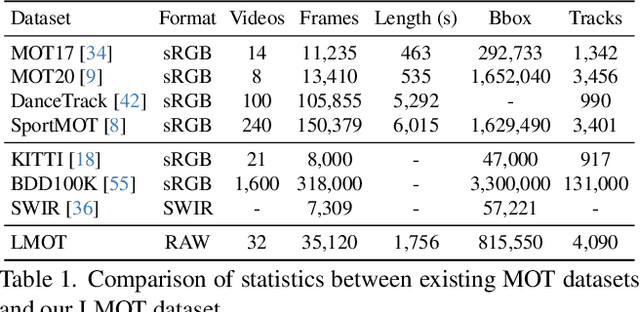Yunhao Zou
EventHDR: from Event to High-Speed HDR Videos and Beyond
Sep 25, 2024



Abstract:Event cameras are innovative neuromorphic sensors that asynchronously capture the scene dynamics. Due to the event-triggering mechanism, such cameras record event streams with much shorter response latency and higher intensity sensitivity compared to conventional cameras. On the basis of these features, previous works have attempted to reconstruct high dynamic range (HDR) videos from events, but have either suffered from unrealistic artifacts or failed to provide sufficiently high frame rates. In this paper, we present a recurrent convolutional neural network that reconstruct high-speed HDR videos from event sequences, with a key frame guidance to prevent potential error accumulation caused by the sparse event data. Additionally, to address the problem of severely limited real dataset, we develop a new optical system to collect a real-world dataset with paired high-speed HDR videos and event streams, facilitating future research in this field. Our dataset provides the first real paired dataset for event-to-HDR reconstruction, avoiding potential inaccuracies from simulation strategies. Experimental results demonstrate that our method can generate high-quality, high-speed HDR videos. We further explore the potential of our work in cross-camera reconstruction and downstream computer vision tasks, including object detection, panoramic segmentation, optical flow estimation, and monocular depth estimation under HDR scenarios.
Technique Report of CVPR 2024 PBDL Challenges
Jun 15, 2024



Abstract:The intersection of physics-based vision and deep learning presents an exciting frontier for advancing computer vision technologies. By leveraging the principles of physics to inform and enhance deep learning models, we can develop more robust and accurate vision systems. Physics-based vision aims to invert the processes to recover scene properties such as shape, reflectance, light distribution, and medium properties from images. In recent years, deep learning has shown promising improvements for various vision tasks, and when combined with physics-based vision, these approaches can enhance the robustness and accuracy of vision systems. This technical report summarizes the outcomes of the Physics-Based Vision Meets Deep Learning (PBDL) 2024 challenge, held in CVPR 2024 workshop. The challenge consisted of eight tracks, focusing on Low-Light Enhancement and Detection as well as High Dynamic Range (HDR) Imaging. This report details the objectives, methodologies, and results of each track, highlighting the top-performing solutions and their innovative approaches.
Multi-Object Tracking in the Dark
May 10, 2024



Abstract:Low-light scenes are prevalent in real-world applications (e.g. autonomous driving and surveillance at night). Recently, multi-object tracking in various practical use cases have received much attention, but multi-object tracking in dark scenes is rarely considered. In this paper, we focus on multi-object tracking in dark scenes. To address the lack of datasets, we first build a Low-light Multi-Object Tracking (LMOT) dataset. LMOT provides well-aligned low-light video pairs captured by our dual-camera system, and high-quality multi-object tracking annotations for all videos. Then, we propose a low-light multi-object tracking method, termed as LTrack. We introduce the adaptive low-pass downsample module to enhance low-frequency components of images outside the sensor noises. The degradation suppression learning strategy enables the model to learn invariant information under noise disturbance and image quality degradation. These components improve the robustness of multi-object tracking in dark scenes. We conducted a comprehensive analysis of our LMOT dataset and proposed LTrack. Experimental results demonstrate the superiority of the proposed method and its competitiveness in real night low-light scenes. Dataset and Code: https: //github.com/ying-fu/LMOT
RawHDR: High Dynamic Range Image Reconstruction from a Single Raw Image
Sep 05, 2023Abstract:High dynamic range (HDR) images capture much more intensity levels than standard ones. Current methods predominantly generate HDR images from 8-bit low dynamic range (LDR) sRGB images that have been degraded by the camera processing pipeline. However, it becomes a formidable task to retrieve extremely high dynamic range scenes from such limited bit-depth data. Unlike existing methods, the core idea of this work is to incorporate more informative Raw sensor data to generate HDR images, aiming to recover scene information in hard regions (the darkest and brightest areas of an HDR scene). To this end, we propose a model tailor-made for Raw images, harnessing the unique features of Raw data to facilitate the Raw-to-HDR mapping. Specifically, we learn exposure masks to separate the hard and easy regions of a high dynamic scene. Then, we introduce two important guidances, dual intensity guidance, which guides less informative channels with more informative ones, and global spatial guidance, which extrapolates scene specifics over an extended spatial domain. To verify our Raw-to-HDR approach, we collect a large Raw/HDR paired dataset for both training and testing. Our empirical evaluations validate the superiority of the proposed Raw-to-HDR reconstruction model, as well as our newly captured dataset in the experiments.
Estimating Fine-Grained Noise Model via Contrastive Learning
Apr 03, 2022



Abstract:Image denoising has achieved unprecedented progress as great efforts have been made to exploit effective deep denoisers. To improve the denoising performance in realworld, two typical solutions are used in recent trends: devising better noise models for the synthesis of more realistic training data, and estimating noise level function to guide non-blind denoisers. In this work, we combine both noise modeling and estimation, and propose an innovative noise model estimation and noise synthesis pipeline for realistic noisy image generation. Specifically, our model learns a noise estimation model with fine-grained statistical noise model in a contrastive manner. Then, we use the estimated noise parameters to model camera-specific noise distribution, and synthesize realistic noisy training data. The most striking thing for our work is that by calibrating noise models of several sensors, our model can be extended to predict other cameras. In other words, we can estimate cameraspecific noise models for unknown sensors with only testing images, without laborious calibration frames or paired noisy/clean data. The proposed pipeline endows deep denoisers with competitive performances with state-of-the-art real noise modeling methods.
 Add to Chrome
Add to Chrome Add to Firefox
Add to Firefox Add to Edge
Add to Edge